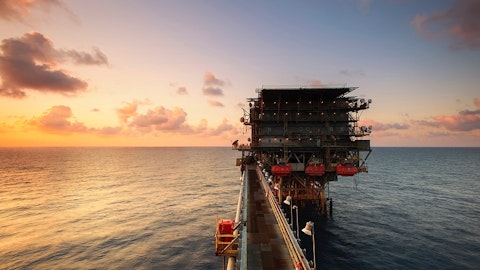So if we can make it work, I think, we get value through the business, our partner in that. And this is a giant basin. This is similar to gas in place to the Marcellus. So if it works, could there be a significant amount of frac work in Australia? Absolutely. But that will take time, that will take time. So for us, we like it because it’s asymmetrical. The downside for us is very small and the upside could be significant.
Atidrip Modak: Great. That makes sense to me. Thank you so much for taking the questions.
Atidrip Modak: Great. Thanks for the questions
Operator: Our next question comes from Stephen Gengaro with Stifel.
Stephen Gengaro: Thanks. Good morning, everybody. Two for me. What I’d start with is, you talked about the digiFracs quite a bit and the strong demand you’re seeing. When you’re in conversations with customers, is there – are they differentiating between your electric frac fleets and the peers? And maybe also as you’re answering that, if you can, when you don’t have the availability right now, are they using your DGBs or are they going elsewhere for electric?
Chris Wright: For the most part, look, where our fleets are going, our existing customers, and I would say the top thing they’re committed to is the quality of Liberty service, and just the way we do business. We’ve been partners for years through good times, through bad times. Look, the biggest sticky is glue is Liberty. Our people, our way of doing business, the quality of service we deliver. The extra upside or the evolution customers want with time is, hey, can we go to fleet that have lower fuel costs and lower emissions, ultimately even smaller footprint with the higher power density. So, but the interest in those technologies are there, but people choose partners and then work together with those partners to find the path to upgrade technology. It’s very rarely, hey, I don’t care who it is. I just want an electric frac fleet. I’m sure there is a customer like that, but that’s – that’s not a Liberty customer.
Stephen Gengaro: Okay, great. Thank you, Chris. And then real quickly, Michael, you mentioned – I might have missed the 2024 CapEx range. Can you just restate that and maybe give some breakdown of how it falls out between the different pieces?
Michael Stock: Yes, we said $500 million to $550 million in cash, probably around about $200 million in capitalized maintenance program. Then, probably the largest portion of the rest of that is going to be in digi and LPI expansions, and we are doing a decent number of dual fuel upgrades, right? We’ve got a number of about 100 Tier 4 pumps that are going to get upgraded, which are the MTUs and a number of our Tier 2s that are our younger Tier 2s are going to get upgraded to dual fuel. But that is a smaller number, because those at great kits are cheaper. They’re not moving from Tier 2 to Tier 4, but we’re upgrading Tier 2s to dual fuel. That’s the basic breakdown.
Stephen Gengaro: Okay, great. Thank you, gentlemen.
Chris Wright: Thanks.
Operator: Your next question comes from Derek Podhaizer with Barclays.
Derek Podhaizer: Hey, good morning, guys. You mentioned every quarter in this year or last year was you set quarterly pumping record. So this clearly supports the production efficiencies that we’ve seen from the E&Ps over the course of the year. Can you expand on the different parts that are driving those pumping records? And if these are structural in nature, should we expect to see these continue going forward?
Chris Wright: I mean, look, there’s a limit in that there’s 24 hours in a day. We had a fleet. I think we announced this, I’m not sure, but yes, we had a fleet that pumped 672 hours in a month. So for that fleet and that performance, there’s not a lot, a whole lot more hours remaining to rise to. But yes, look, these are a combination of supply chain. You got to bring sand, chemicals, everything on location. You don’t hear about it so much, but disruptions in those, they slow down frac operations. It’s one of the reasons Liberty really developed this integrated delivery of stuff that arrived there. It’s people, it’s equipment, it’s our partners. A lot of the efficiency we have, we couldn’t have with different partners, forming partnerships with Liberty.
It’s a lot about how can we work together to get better. Let me turn it over to Ron to give a little more color. But boy, it’s from software. It’s from humans, it’s equipment maintenance. But Ron…
Ron Gusek: Yes, the only other thing I was going to add on there was the development around the software side of things. We’ve done and made a pretty significant investment over the last year, two years, on artificial intelligence, our ability to understand our equipment to predict failure in advance of it happening, and to be far more proactive about the maintenance of the equipment. And so I think if you look at that in terms of how it translates to performance of the assets out in the field, we have come a long, long ways on that. You’ll continue to see some improvement on that on the digi side, I think. But as Chris alluded to, we just don’t have a lot of room left to move there. But as our equipment continues to get more sophisticated, more advanced, and we continue to drive out time between major maintenance intervals and even longer uptime for things like pump components. We continue to eke out those incremental minutes on location.
Chris Wright: I’ll add one other thing. So we took over a wireline business three years ago. We’ve changed humans there. We changed procedures. That took us time. We got into the wireline business. If you looked at the Kimberlite surveys every year, Kimberlite has done the survey, Liberty is ranked as the top frac company since they began the survey. We worked at the start to top wireline company. In fact, we may have been more stud the other way. But more recently, and today, we are the number one ranked wireline company. So one of the things we look at is when we have a Liberty wireline truck with a Liberty frac fleet, you have left downtime. So of course, that’s the majority of our fleets now, those are paired but not all of them. So there’s still room for improvement for us. But obviously, the low-hanging fruit gets picked first. And now it’s about continued optimization, but less upside there.



